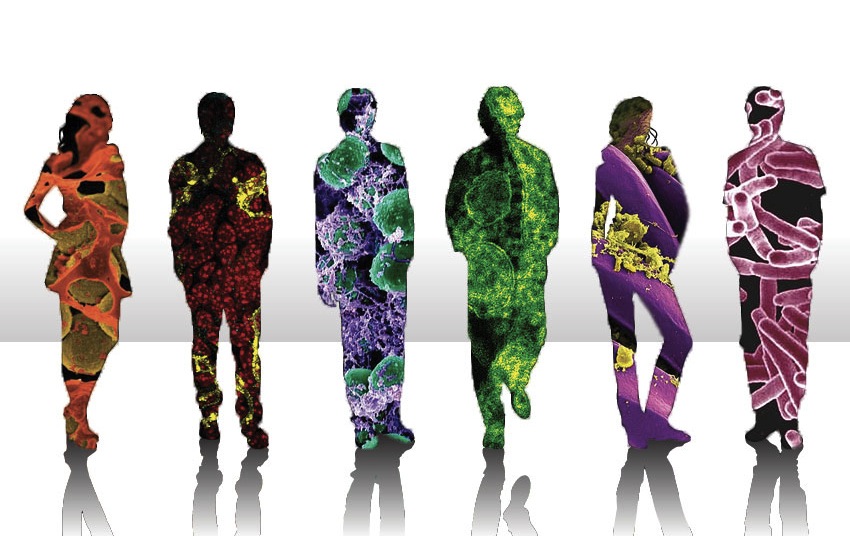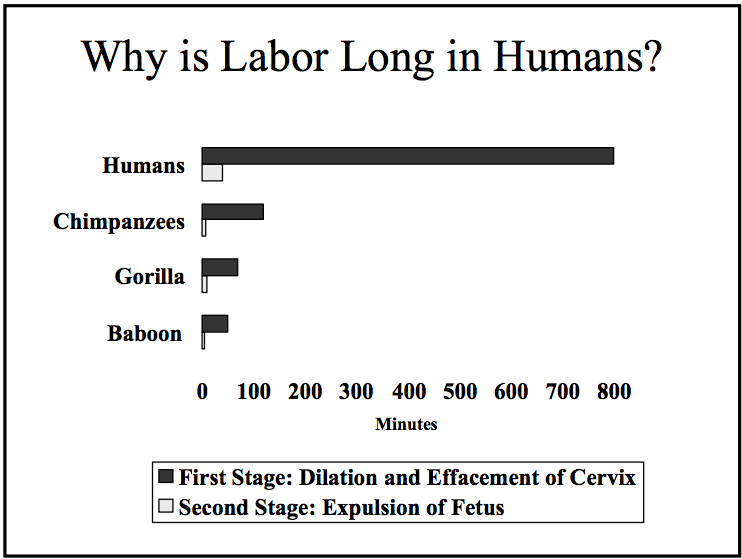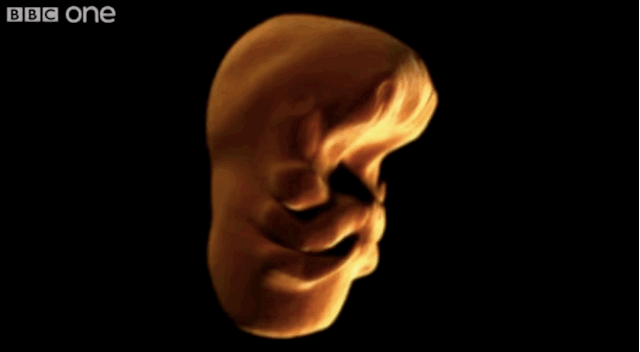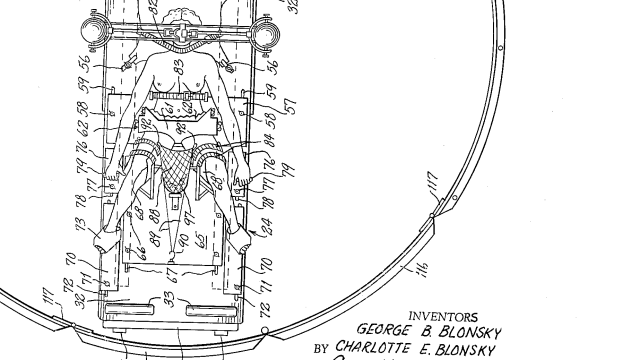Everyone on Earth has been through it, but there’s a lot about birth that you’re probably unfamiliar with. Here’s thirteen facts about the human birthing process you may not have picked up in biology class.
13. In An Alternate Timeline, Birth Might Have Been Aided By Centrifugal Force
In the 1960s, inventors Charlotte and George Blonksy devised an “apparatus for facilitating the birth of a child by centrifugal force.” The device, which is pictured at the top of the post and described in further detail here, was designed to “assist and supplement” the natural efforts of the mum, who is strapped into the apparatus, “so that such centrifugal force and her efforts act in concert to overcome the action of resisting forces and facilitate the delivery of the child.” Blessedly, the “Blonksy Device” never really caught on.
12. Postpartum Depression Isn’t Always Postpartum, or Depression
The New York Times last month reported on the growing body of research that suggests mental illness in new mothers and mums-to-be is not only more common than once believed, but more varied. Recent findings challenge the view that symptoms begin in the weeks immediately following childbirth, and that those symptoms are limited to ones of depression:
In fact, depression often begins during pregnancy… and can develop any time in the first year after a baby is born… In the year after giving birth, studies suggest, at least one in eight and as many as one in five women develop symptoms of depression, anxiety, bipolar disorder, obsessive-compulsive disorder or a combination. In addition, predicting who might develop these illnesses is difficult, scientists say. While studies are revealing clues as to who is most vulnerable, there are often cases that appear to come out of nowhere.
…Depression [during] pregnancy can be missed because symptoms like trouble sleeping and moodiness also occur in pregnant women who are not depressed. And doctors have historically been taught in medical school that “women don’t get depressed during pregnancy because they are happy,” said Dr. Katherine L. Wisner, a professor of psychiatry and obstetrics at Northwestern University.
11. Babies Born In Space Would Likely Have Problems
Pregnant rats that are sent to space give birth to pups on Earth with an impaired sense of direction. They struggle with basic orientation, and have difficulty righting themselves when thrown into water. The pups do, however, tend to be better at processing orientations common during weightlessness, suggesting that a baby gestated and born in space might actually have an easier time navigating their zero-G environment than one born here on Earth.
That being said, there’s reason to believe that children raised in space would face considerable developmental challenges. That’s assuming, of course, that it’s even possible to become pregnant in space. Sperm do weird things in aberrant gravitational environments.
10. Part of Your Microbiome Is Planted During Birth

Image by Lauren Davis, sources via Shutterstock
Every one of our bodies is an ecosystem, home to an estimated 100-trillion bacteria called, collectively, our “microbiome.” Many of the microbes found in a baby’s gut are believed to be acquired during birth, when an infant is exposed to the microbe-rich environments of their mothers’ vagina and intestines.
9. But Your Microbiome May Also Begin Taking Shape Before You’re Born
It was long assumed that fetuses developed in a sterile womb and took on their first bacterial tenants during birth, upon exposure to the microbial communities mentioned above. But in the last decade or so, several studies have called the concept of the sterile womb into question. Increasingly, scientists are beginning to suspect that women actually “seed” their fetuses’ microbiomes with bacterial populations prior to birth, during pregnancy. The means of bacterial transmission, the makeup of these foundational populations, and the degree to which an unborn baby’s nascent microbiome can be targeted for manipulation remains less clear.
8. The Placenta Is a Lot Like Your Mouth
One piece of evidence that fetuses may acquire bacteria in the womb was the discovery, published in May, that DNA from a variety of microbes can be found in the placentas of healthy pregnant women. More intriguing still: when researchers compared the placental microbiomes of pregnant women to the skin, oral, nasal, vaginal, and gut microbiomes from nonpregnant controls, they found that the microorganismal makeup of the placenta most closely resembled that of the mouth. (A fascinating, if widely overhyped, observation.)
7. Bringing a Child to Term Costs More in America Than Anywhere Else

Image by RTGonzalez. Source via Shutterstock
According to a survey conducted by Truven Health Analytics on behalf of the
New York Times, charges for delivery have about tripled in the U.S. since 1996.’
6. The U.S. Also Has The Highest First-Day Infant Death Rate In the Industrialized World
Via Save the Children’s State of the World’s Mothers 2013 Report:
Only 1 per cent of the world’s newborn deaths occur in industrialized countries, but the newborn period is still the riskiest time, no matter where a baby is born, with the first day being the riskiest time of all in most, if not all, countries. The United States has the highest first-day death rate in the industrialized world. An estimated 11,300 newborn babies die each year in the United States on the day they are born. This is 50 per cent more first-day deaths than all other industrialized countries combined.
5. America’s Stats: Bad For Mums, Too
Research published in the May issue of The Lancet illustrates how the surprising disparity in birthing safety applies to mothers, as well. Tracy Cassel summarises The Lancet’s reviewin a recent post at Evolutionary Parenting, where she notes that a mother is more likely to die from childbirth-related problems in America than Albania:
In 1990, the USA was ranked 22 in maternal health and mortality. This year, the USA ranks 60th after dropping from 50th in the last assessment. In fact, the US is one of only 8 countries to have seen a rise in maternal morality, up from 17.6 in 2003 to 18.5 deaths/100,000 in 2013 (the other 7 were Afghanistan, Belize, El Salvador, Guinea-Bissau, Greece, Seychelles, and the South Sudan). In 1987 that number was 7.2/100,00.
…Canada and New Zealand have maternal mortality rates that are half of the USA. The UK has one that is a third. Australia’s is a quarter of the USA’s. Albania, Bosnia and Herzegovina, Bulgaria, Croatia, Romania, Kuwait, Lebanon, Iran, and Serbia all have rates that are lower than that of the USA.
4. Birth Is Surprisingly Risky
Birth is a high-risk affair for mammals, in general, but it’s especially so for humans. The constraints of the narrow human pelvis, thought to be an evolutionary tradeoff of walking on two legs, combined with the exceptionally large heads of human babies, makes human birth especially difficult, and therefore dangerous, compared to other animals.
3. So Where Are Mums Least Likely To Face Birth Risks?

Photo Credit: Moyan Brenn | CC BY 2.0
That would be Iceland — home to gorgeous vistas, crazy-maned ponies and maternal mortality rates of just 2.4/100,000 (roughly 1/8th that of the U.S.).
2. Human Labour Is Also Exceptionally Long (And Painful)

Image Credit: Dr. Cheryll Knott via
To accommodate big-headed babies, a human’s cervix has to dilate a lot — about three times wider than it does in apes. Not only does greater cervical dilation require more time, these later stages of dilation are also more painful. As the Mayo Clinic notes, the beginning stages cervical dilation are so mild that many women report feeling perfectly content to continue going about their daily lives. It’s further along in childbirth, as the body prepares for active labour by dilating the cervix to 8, 9, or more than 10 centimeters across, that humans experience the most pain.
1. At One Point In Life, We All Looked Like Admiral Ackbar

In 2011, researchers were first able to acquire scans of a baby’s face, taken between the second and third months of fetal development, and combine them into the morphing animation you see here. Ever wonder where the dimple above your lip comes from? Wonder no more.
